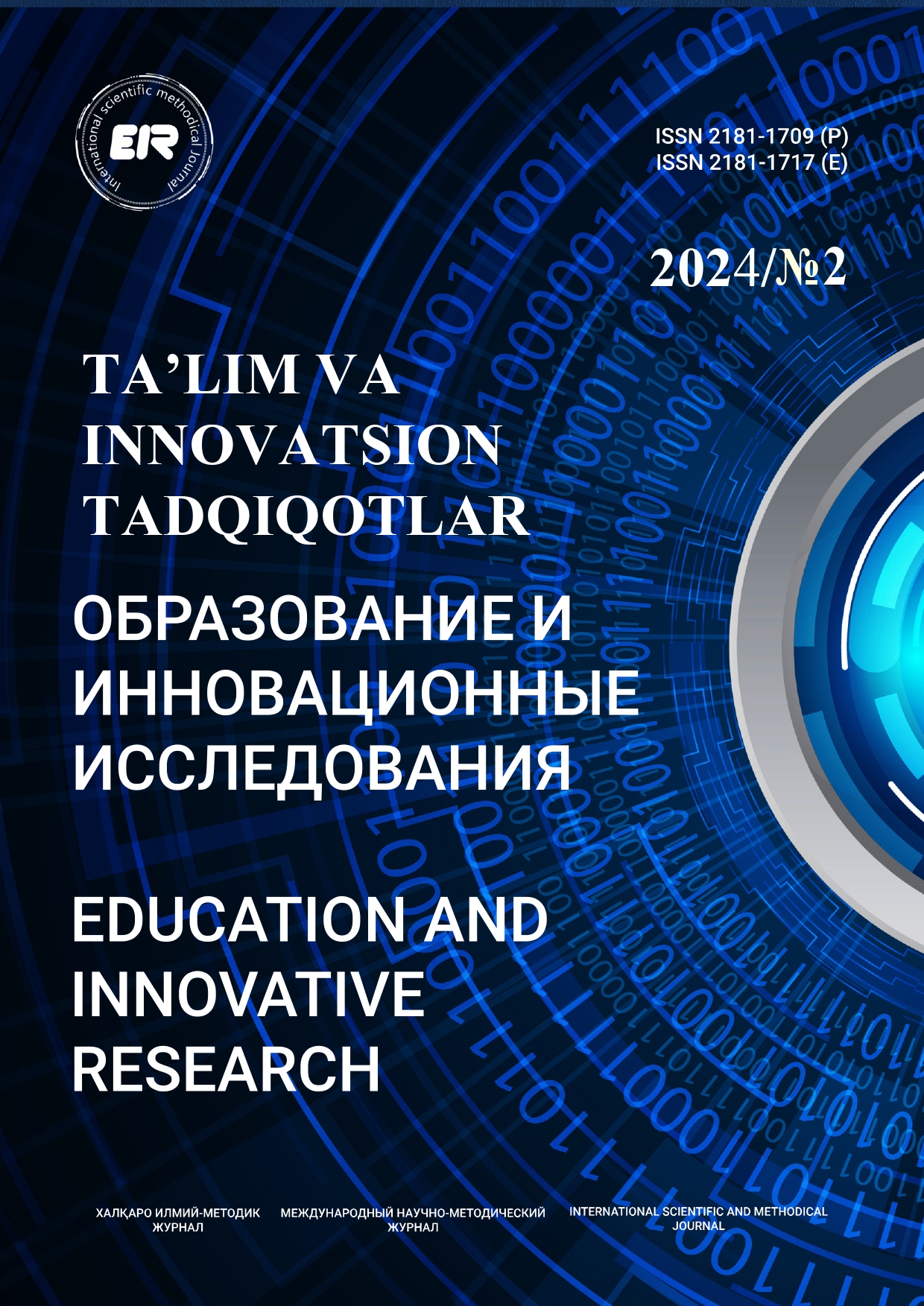КРИТИЧЕСКОЕ МЫШЛЕНИЕ ЧЕРЕЗ ЧТЕНИЕ: ПРИМЕНЕНИЕ СТРАТЕГИИ ВОПРОСНО-ОТВЕТНЫХ ОТНОШЕНИЙ (QAR)
Марданова Зилола, преподаватель Узбекского Государственного Университета Мировых Языков.
Ключевые слова:
способности, критическое мышление, понимание прочитанного, стратегия, стратегия соотношения вопрос-ответ (QAR), обучение, когнитивные навыки.Аннотация
Студенты, изучающие английский как иностранный язык (EFL), должны понимать текст на английском языке и уметь критически мыслить в процессе обучения. Однако развитие этих двух важных способностей в процессе изучение и преподавание остается актуальной проблемой для учителей и студентов. Фактически, использование неправильной стратегии обучения является одной из основных причин проблем. Эта статья направлена на изучение эффективности стратегий взаимоотношений вопросов и ответов (QAR) путем рассмотрения трех исследовательских вопросов. Стратегия QAR использовалась в экспериментальной и контрольной группах во время регулярных сеансов чтения для продолжительности вставки. В результате стратегия значительно улучшила способность студентов понимать прочитанное и критически мыслить.
Библиографические ссылки
Arisoy, B., Aybek, B. (2021). The effects of subject-based critical thinking education in Mathematics on students’ critical thinking skills and virtues. Eurasian Journal of Educational Research, 92, 99–120. https://doi.org/10.14689/ ejer.2021.92.6.
Bakhtiari Moghadam, Z., Haddad Narafshan, M., & Tajadini, M. (2021). Development of a critical self in the language reading classroom: An examination of learners’ L2 self. Thinking Skills and Creativity. https://doi.org/10.1016/j. tsc.2021.100944.
Beck, I.L. and McKeown, M.G. (2007) ‘Increasing young low‐income children’s oral vocabulary repertoires through rich and focused instruction’, The Elementary School Journal, 107(3), pp. 251–271. doi:10.1086/511706.
Davies, M. (2013). Critical thinking and the disciplines reconsidered. Higher Education Research & Development, 32(4), 529–544. https://doi.org/10.1080/ 07294360.2012.697878.
Duke, N.K. and Pearson, P.D. (2002) ‘Effective practices for developing reading comprehension’, What Research Has to Say About Reading Instruction, pp. 205–242. doi:10.1598/0872071774.10.
Gollan, T. H., Montoya, R. I., Cera, C., & Sandoval, T. C. (2008). More use almost always means a smaller frequency efect: Aging, bilingualism, and the weaker links hypothesis. Journal of Memory and Language, 58(3), 787–814.
Grabe, W., & Stoller, F. L. (2002). Teaching and researching. Allyn & Bacon.
Halpern, D. F. (2014). Thought and knowledge: An introduction to critical thinking. New York, NY: Psychology Press.
Heidari, K. (2020). Critical thinking and EFL learners’ performance on textually-explicit, textually-implicit, and script-based reading items. Thinking Skills and Creativity. https://doi.org/10.1016/j.tsc.2020.100703.
Izura, C., & Ellis, A. W. (2004). Age of acquisition efects in translation judgement tasks. Journal of Memory and Language, 50(2), 165–181 Ketabi, S., Zabihi, R., & Ghadiri, M. (2012). Critical thinking across the ELT curriculum: A mixed methods approach to analyzing L2 teachers’ attitudes towards critical thinking instruction. International Journal of Research Studies in Education, 2(3), 15–24.
Kintsch, W. (1993) ‘A comprehension-based approach to learning and understanding’, Psychology of Learning and Motivation, pp. 165–214. doi:10.1016/s0079-7421(08)60297-2.
Kintsch, W. (1998). Comprehension: A paradigm for cognition. Cambridge university press.
Kintsch, W., & Van Dijk, T. A. (1978). Toward a model of text comprehension and production. Psychological Review, 85(5), 363–394.
Lai, E. R. (2011). Critical thinking: A literature review. Pearson’s Research Reports, 6, 40–41. https://images. pearsonassessments.com/images/tmrs/ CriticalThinkingReviewFINAL.pdf.
Le, B., & Hockey, J. (2022). Critical thinking in the higher education classroom: Knowledge, power, control and identities. British Journal of Sociology of Education, 43 (1), 140–158. https://doi.org/10.1080/01425692.2021.2003182.
Marin, M.A., & de la Pava, L. (2017). Conceptions of critical thinking from university EFL teachers. English Language Teaching, 10(7), 78–88.
Moghadam, B., Narafshan, H., Tajadini, M. (2023). The efect of implementing a critical thinking intervention program on English language learners’ critical thinking, reading comprehension, and classroom climate. Asian Pacific Journal of Second and Foreign Language Education. 8:15 https://doi.org/10.1186/s40862-023-00188-3.
Moore, T. (2011b). Critical thinking and disciplinary thinking: A continuing debate. Higher Education Research & Development, 30(3), 261–274. https://doi.org/ 10.1080/07294360.2010.501328.
Moore, T. J. (2004). The critical thinking debate: How general are general thinking skills? Higher Education Research & Development, 23(1), 3–18. https://doi.org/ 10.1080/0729436032000168469.
Moore, T. J. (2011a). Critical thinking: History, definitions, issues. Critical thinking and language: The challenge of generic skills and disciplinary discourses (pp. 7–38). London: Bloomsbury Academic, 1 ed. https://www.bloomsburycollections. com/book/critical-thinking-and-language-the-challenge-of-generic-skills-anddisciplinary-discourses/ ch2-critical-thinking-history-definitions-issues.
Nassaji, H. (2011). Issues in second-language reading: Implications for acquisition and instruction. Reading Research Quarterly, 46(2), 173–184.
Perfetti, C. (2007). Reading ability: Lexical quality to comprehension. Scientifc Studies of Reading, 11(4), 357–383.
Petek, E., & Bedir, H. (2018). An adaptable teacher education framework for critical thinking in language teaching.
Thinking Skills and Creativity, 28, 56–72.
Raphael, T. E. (1986). Teaching question answer relationship, revisited. The Reading Teacher, 39(6), 516-522.
Snow, C. (2002). Reading for understanding: Toward an R&D program in reading comprehension. Rand Corporation.
Tan, C. (2017). Teaching critical thinking: Cultural challenges and strategies in Singapore. British Educational Research Journal, 43(5), 988–1002.
Willingham, D. T. (2008). Critical thinking: Why is it so hard to teach? Arts Education Policy Review, 109(4), 21–32. https://doi.org/10.3200/AEPR.109.4.21-32.
Xuelian Li, Jianda Liu, Validating a critical thinking ability questionnaire for EFL learners, Thinking Skills and Creativity, Volume 51, 2024, 101442, ISSN 1871-1871, https://doi.org/10.1016/j.tsc.2023.101442. (https://www. sciencedirect.com/science/article/pii/S1871187123002109).
Yuan, R., Liao, W., Wang, Z., Kong, J., & Zhang, Y. (2022). How do English-as-a-foreign-language (EFL) teachers perceive and engage with critical thinking: A systematic review from 2010 to 2020. Thinking Skills and Creativity, 40. https://doi.org/10.1016/j.tsc.2021.100832.
Yuan, R., Yang, M., & Lee, I. (2021). Preparing pre-service language teachers to teach critical thinking: Can overseas field school experience make a difference? Thinking Skills and Creativity, 40, Article 100832 (2021), Article.
Zhang, H., Yuan, R., & He, X. (2020). Investigating university EFL teachers’ perceptions of critical thinking and its teaching: Voices from China. The Asia-Pacific Education Researcher, 29(5), 483–493.





